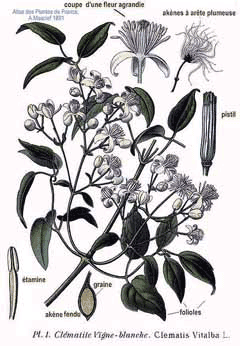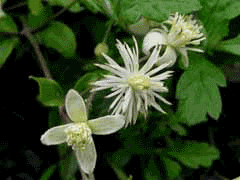 |
|
http://commons.wikimedia.org/wiki/File:1_Clematis_vitalba_L.jpg |
 |
| http://commons.wikimedia.org/wiki/User:Pethan |
Translate this page:
Summary
Physical Characteristics

 clematis vitalba is a deciduous Climber growing to 15 m (49ft) by 15 m (49ft) at a fast rate.
clematis vitalba is a deciduous Climber growing to 15 m (49ft) by 15 m (49ft) at a fast rate.
See above for USDA hardiness. It is hardy to UK zone 4. It is in flower from July to September, and the seeds ripen from October to January. The species is hermaphrodite (has both male and female organs) and is pollinated by Bees, flies.
Suitable for: light (sandy), medium (loamy) and heavy (clay) soils and prefers well-drained soil. Suitable pH: mildly acid, neutral and basic (mildly alkaline) soils and can grow in very alkaline soils.
It can grow in semi-shade (light woodland) or no shade. It prefers moist soil.
UK Hardiness Map
US Hardiness Map
Synonyms
Plant Habitats
Woodland Garden Dappled Shade; Shady Edge; Hedgerow;
Edible Uses
Edible Parts: Leaves Shoots
Edible Uses:
Young shoots - cooked and used like hop shoots (Humulus lupulus)[7, 46, 61]. Caution is advised due to reports of toxicity[7].
References More on Edible Uses
Medicinal Uses
Plants For A Future can not take any responsibility for any adverse effects from the use of plants. Always seek advice from a professional before using a plant medicinally.
Analgesic Bach Diuretic Homeopathy Rubefacient Skin
The leaves are analgesic, diuretic and rubefacient[7, 61]. The boiled roots and stems are used as a cure for the itch[4]. When applied in the nostrils, the plant juice has been used to relieve migraine attacks, but it can also destroy the mucous membranes[7]. The plant should not be taken internally because it is poisonous[7]. A homeopathic remedy is made from the plant. It is used in the treatment of rheumatism and skin eruptions[238]. The plant is used in Bach flower remedies - the keywords for prescribing it are 'Indifference', 'Dreaminess', 'Inattention' and 'Unconsciousness'[209]. It is also one of the five ingredients in the 'Rescue remedy'[209].
References More on Medicinal Uses
The Bookshop: Edible Plant Books
Our Latest books on Perennial Plants For Food Forests and Permaculture Gardens in paperback or digital formats.

Edible Tropical Plants
Food Forest Plants for Hotter Conditions: 250+ Plants For Tropical Food Forests & Permaculture Gardens.
More

Edible Temperate Plants
Plants for Your Food Forest: 500 Plants for Temperate Food Forests & Permaculture Gardens.
More

More Books
PFAF have eight books available in paperback and digital formats. Browse the shop for more information.
Shop Now
Other Uses
References More on Other Uses
Cultivation details
Prefers a deep moist soil with its roots in the shade[11, 200]. Dislikes poorly-drained heavy clay soils, but grows well in clay if grit is added for drainage[11, 200]. Dislikes light sandy soils[11]. Does well on chalk[1]. Dislikes acid soils below a pH of 6.0[186]. Succeeds in acid as well as alkaline soils[200]. Plants are hardy to about -18°c[202]. A twining plant[182]. The leafstalks wrap themselves around twigs and branches for support. When a side of the stalk touches an object, the growth on that side slows down whilst the other side grows at its normal rate - this causes the leaf stalk to entwine the object it is touching[186, 212]. It is capable of growing 2 metres in a year and can easily smother small trees and shrubs[186]. Another report says that it can grow 5 metres in a year[202]. When planting out, in order to avoid the disease 'clematis wilt', it is best to plant the rootball about 8cm deeper in the soil. This will also serve to build up a good root crown of growth buds[200]. The flowers are almond-scented[202]. They are produced on the current season's growth[219]. The plant is very amenable to pruning and can be cut back severely if required. This is best done in early spring[202]. A greedy plant, inhibiting growth of nearby plants, especially legumes[54]. Plants seem to be immune to the predations of rabbits[233]. This species is notably resistant to honey fungus[88, 200].
References Carbon Farming Information and Carbon Sequestration Information
Temperature Converter
Type a value in the Celsius field to convert the value to Fahrenheit:
Fahrenheit:
The PFAF Bookshop
Plants For A Future have a number of books available in paperback and digital form. Book titles include Edible Plants, Edible Perennials, Edible Trees,Edible Shrubs, Woodland Gardening, and Temperate Food Forest Plants. Our new book is Food Forest Plants For Hotter Conditions (Tropical and Sub-Tropical).
Shop Now
Plant Propagation
Seed - best sown as soon as it is ripe in a cold frame[164, 200]. Sow stored seed as soon as it is obtained in a cold frame. Pre-soak the seed for 12 hours in warm water and remove as much of the tail and outer coat as possible[164]. A period of cold stratification is beneficial[164]. The seed germinates in 1 - 9 months or more at 20°c[164]. Prick out the seedlings into individual pots when they are large enough to handle and grow them on in a cold frame for their first winter. Plant out in late spring or early summer, after the last expected frosts. Cuttings of half-ripe wood, taken between nodes, July/August in a frame[1]. Internodal cuttings of soft to semi-ripe wood, late spring in sandy soil in a frame. Layering of old stems in late winter or early spring[200]. Layering of current seasons growth in early summer[200].
Other Names
If available other names are mentioned here
Traveller's joy, Old man's beard, Clematide vitalba, Vezzadro, Vitalba,
Native Range
TEMPERATE ASIA: Afghanistan, Cyprus, Iran (north), Lebanon, Syria, Turkey, Russian Federation-Ciscaucasia (Ciscaucasia), Armenia, Azerbaijan, Georgia EUROPE: United Kingdom, Austria, Belgium, Switzerland, Czech Republic, Germany, Hungary, Netherlands, Poland, Slovakia, Russian Federation (European part), Ukraine (Krym (incl. Krym)), Albania, Bulgaria, Bosnia and Herzegovina, Greece, Croatia, Italy (incl. Sardinia, Sicily), North Macedonia, Montenegro, Romania, Serbia, Slovenia, Spain, France (incl. Corsica), Portugal AFRICA: Algeria (north)
Weed Potential
Right plant wrong place. We are currently updating this section.
Please note that a plant may be invasive in one area but may not in your area so it's worth checking.
This plant can be weedy or invasive. Clematis vitalba is an invasive plant in most places, including many in which it is native. Plant with care.
Conservation Status
IUCN Red List of Threatened Plants Status : This taxon has not yet been assessed.

Growth: S = slow M = medium F = fast. Soil: L = light (sandy) M = medium H = heavy (clay). pH: A = acid N = neutral B = basic (alkaline). Shade: F = full shade S = semi-shade N = no shade. Moisture: D = dry M = Moist We = wet Wa = water.
Now available:
Food Forest Plants for Mediterranean Conditions
350+ Perennial Plants For Mediterranean and Drier Food Forests and Permaculture Gardens.
[Paperback and eBook]
This is the third in Plants For A Future's series of plant guides for food forests tailored to
specific climate zones. Following volumes on temperate and tropical ecosystems, this book focuses
on species suited to Mediterranean conditions—regions with hot, dry summers and cool, wet winters,
often facing the added challenge of climate change.
Read More
Expert comment
Author
L.
Botanical References
1117200
Links / References
For a list of references used on this page please go here
Readers comment
| Add a comment |
|
If you have important information about this plant that may help other users please add a comment or link below. Only comments or links that are felt to be directly relevant to a plant will be included. If you think a comment/link or information contained on this page is inaccurate or misleading we would welcome your feedback at [email protected]. If you have questions about a plant please use the Forum on this website as we do not have the resources to answer questions ourselves.
* Please note: the comments by website users are not necessarily those held by PFAF and may give misleading or inaccurate information.
To leave a comment please Register or login here All comments need to be approved so will not appear immediately.
|
Subject : clematis vitalba
|
|
|
|